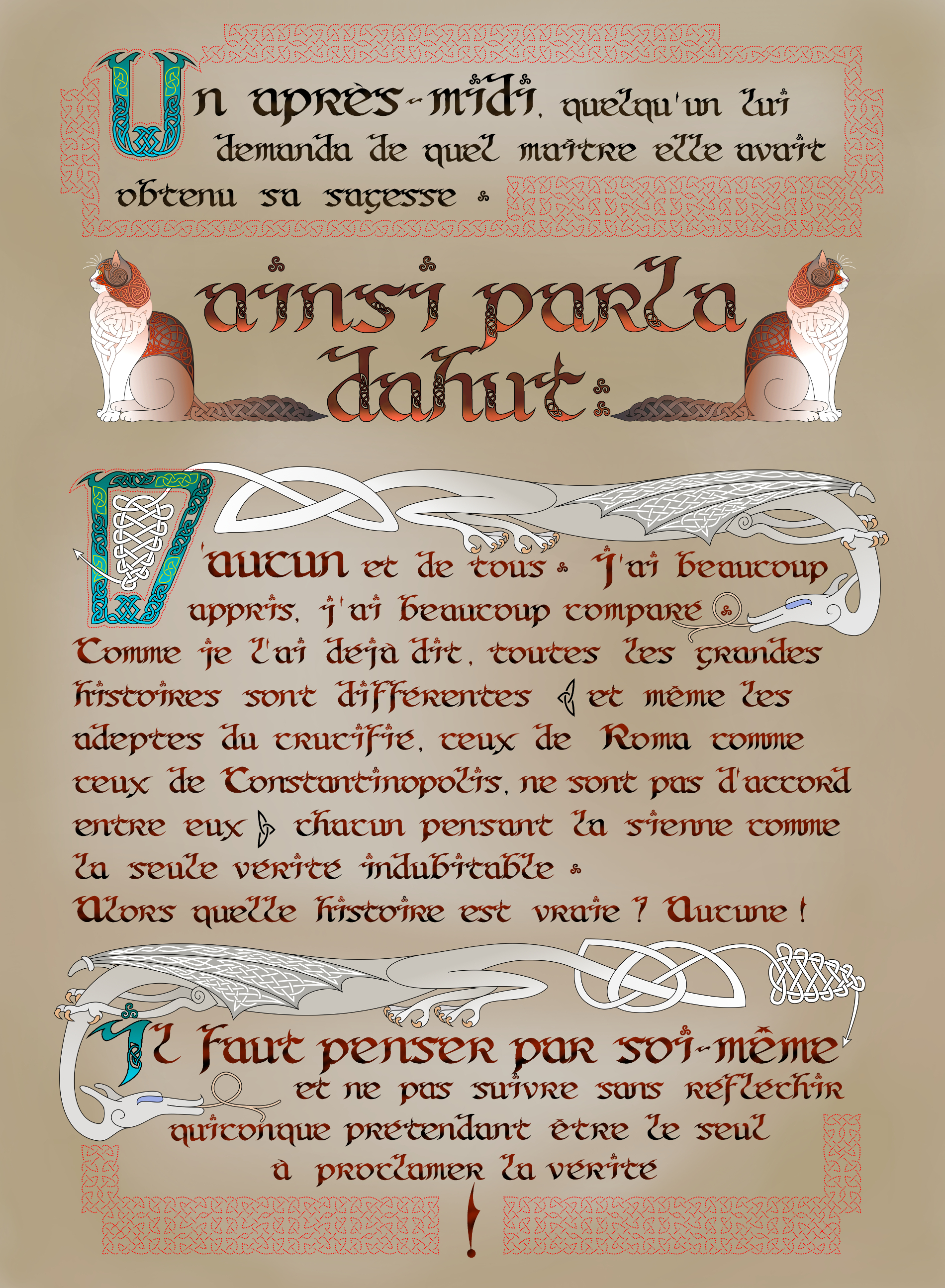fol. 7v
Un après-midi, quelqu'un lui demanda de quel maître elle avait obtenu sa sagesse.
Ainsi parla Dahut:
- D'aucun et de tous. J'ai beaucoup appris, j'ai beaucoup comparé. Comme je l'ai déjà dit, toutes les grandes histoires sont différentes (et même les adeptes du crucifié, ceux de Constantinopolis comme ceux de Roma, ne sont pas d’accord entre eux(1)), chacun pensant la sienne comme la vérité indubitable. Alors quelle histoire est vraie? Aucune! Il faut penser par soi-même et ne pas suivre sans réfléchir quiconque prétendant être le seul à proclamer la vérité.
(1) Extraits de Wikipedia: Séparation des Églises d'Orient et d'Occident:
"Les provinces orientales de l’Empire romain avaient le grec comme langue d’usage et avaient conservé la culture hellénistique, plus individualiste et portée vers la philosophie que la culture romaine des provinces occidentales, plus autoritaire et juridique. L’éducation y étant plus répandue qu’en Occident, laïcs autant qu’ecclésiastiques prenaient grand plaisir à la spéculation théologique.
Convaincu que le devoir de l’Empereur était de maintenir sur terre le même ordre et la même harmonie que Dieu dans le ciel, Constantin fut rapidement confronté à deux hérésies, dont l’arianisme qui prêchait que seul Dieu le Père existait de toute éternité alors que le Fils avait été créé à un moment déterminé.
Devant la résistance des ariens, Constantin décida de convoquer, en 325, le premier concile œcuménique, dit de Nicée. Arius et ses partisans furent alors excommuniés. Réadmis dans l’Église au concile de Jérusalem en 325, ils furent à nouveau condamnés en 333.
Les grandes querelles christologiques qui déchirèrent l’Église au cours des siècles suivants contribuèrent à éloigner les Églises d'Orient et d'Occident.
Apparue au Ve siècle dans l'Empire romain d'Orient, la doctrine du monophysisme affirmait que le Fils n'avait qu'une seule nature, la nature divine, laquelle aurait absorbé sa nature humaine. Le concile de Chalcédoine en 451 avait condamné cette doctrine et proclamé que le Christ avait deux natures, la nature divine et la nature humaine, jointes en une seule personne. La notion des deux natures du Christ offensait les gens d’Alexandrie qui tendaient à favoriser le monophysisme, alors que Rome et Antioche voulaient maintenir la distinction entre les deux natures (duophysisme). Constantinople se trouvait prise entre les deux positions. En dépit de ses efforts de conciliation, l’Empereur dut s’incliner devant la volonté du pape Léon Ier et le concile décida que le Christ avait deux natures, distinctes mais inséparables. Les réactions en Syrie, en Égypte et en Palestine ne se firent pas attendre : la nomination d’un nouvel évêque se solda par un bain de sang dans les rues d’Alexandrie, alors que les moines se rebellèrent et installèrent un nouvel évêque à Jérusalem."
Etcetera.
fol.7v
One afternoon someone asked her from which master she had obtained her wisdom.
Thus spoke Dahut:
- From no one and from all. I learned a lot, I compared a lot. As I said before, all great stories are different (and even the followers of the crucified in Constantinopolis disagree with those in Roma(1)), each believing his own story as the unmistakable truth. So which story is true? None! Think for yourself and don't follow mindlessly anyone who claims to be the only one telling the truth.
(1) Excerpts from Wikipedia: Séparation des Églises d'Orient et d'Occident :
"The eastern provinces of the Roman Empire had Greek as their language of use and had retained the Hellenistic culture, more individualistic and inclined towards philosophy than the Roman culture of the western provinces, which was more authoritarian and legal. Education there being more widespread than in the West, laymen as well as ecclesiastics took great pleasure in theological speculation.
Convinced that the duty of the Emperor was to maintain on earth the same order and the same harmony as God in heaven, Constantine was quickly confronted with two heresies, including Arianism which preached that only God the Father existed in all eternity and that the Son was created at a certain time.
Faced with the resistance of the Arians, Constantine decided to convene, in 325, the first ecumenical council, known as of Nicaea. Arius and his followers were then excommunicated. Readmitted to the Church at the Council of Jerusalem in 325, they were again condemned in 333.
The great Christological quarrels which tore the Church apart over the following centuries helped to drive the Churches of East and West away from each other.
Appeared in the fifth century in the Eastern Roman Empire, the doctrine of monophysism affirmed that the Son had only one nature, the divine nature, which would have absorbed his human nature. The Council of Chalcedon in 451 condemned this doctrine and proclaimed that Christ had two natures, the divine nature and the human nature, joined in one person. The notion of the two natures of Christ offended the people of Alexandria who tended to favor monophysism, while Rome and Antioch wanted to maintain the distinction between the two natures (duophysism). Constantinople was caught between the two positions. Despite his efforts at conciliation, the Emperor had to bow to the will of Pope Leo I, and the council decided that Christ had two natures, distinct but inseparable. The reactions in Syria, Egypt and Palestine were not long in coming: the appointment of a new bishop resulted in a bloodbath in the streets of Alexandria, as the monks rebelled and installed a new bishop in Jerusalem . "
And so on...
Cliquez l'image pour une meilleure qualité.
Click on the picture for a better quality.

